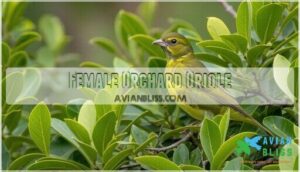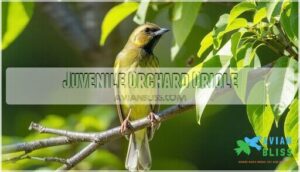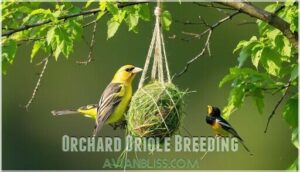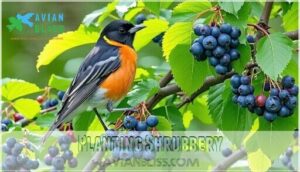This site is supported by our readers. We may earn a commission, at no cost to you, if you purchase through links.
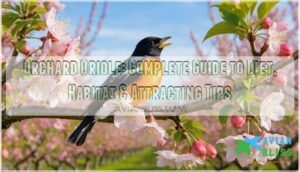
You’ll find these insect-hunting acrobats weaving through open woodlands, orchards, and river edges, where they feast on beetles, caterpillars, and sweet nectar from flowering trees.
Males sport brilliant orange bodies with black wings and heads, while females wear subtle yellow-green tones that blend beautifully with foliage.
These nimble birds build their pendant nests in tree branches, creating intricate woven pouches that sway gently in summer breezes.
Their seasonal diet shifts from protein-rich insects during breeding season to fruits and nectar as they prepare for their long journey south.
The secrets to creating an orchard oriole paradise in your own yard might surprise you.
Table Of Contents
- Key Takeaways
- Orchard Oriole Diet
- Orchard Oriole Habitat
- Orchard Oriole Appearance
- Orchard Oriole Breeding
- Attracting Orchard Orioles
- Frequently Asked Questions (FAQs)
- How rare is an Orchard Oriole?
- What’s the difference between an Orchard Oriole and a Baltimore oriole?
- What does a female Orchard Oriole look like?
- What is the difference between a Baltimore oriole and an orchard oriole?
- Where are Orchard Orioles found?
- What do Orchard Orioles like to eat?
- How to attract Orchard Orioles?
- What does a male orchard oriole look like?
- What do Orchard orioles eat?
- Where do Orchard orioles live?
- Conclusion
Key Takeaways
- You’ll attract orchard orioles by offering nectar feeders, fresh orange halves, grape jelly, and planting berry-producing trees like mulberry and chokeberry rather than using traditional seed feeders.
- You can identify males by their striking black heads and wings with chestnut-orange bodies, while females display subtle greenish-yellow plumage with white wing bars.
- You’ll find these birds in open woodlands, parks, orchards, and river edges where they build intricate hanging pouch nests from grass and plant fibers.
- You’ll notice their diet shifts dramatically from 90% insects and spiders during breeding season to fruits, nectar, and berries during fall migration and winter months.
Orchard Oriole Diet
You’ll find that orchard orioles have a varied diet that changes with the seasons, focusing primarily on insects and spiders during breeding season while switching to fruits and nectar during migration and winter months.
Understanding their feeding preferences can help you create the perfect backyard habitat to attract these beautiful birds to your property.
Insects and Spiders
Nearly 90% of an orchard oriole’s diet consists of insects and spiders during breeding season.
Here’s a short, engaging blockquote in the same tone:
These feathered pest controllers devour thousands of insects each season, making them nature’s ultimate garden allies.
These skilled hunters use precise foraging techniques to capture arthropods that provide essential protein for their growing chicks.
They often nest near eastern kingbirds, who provide protection.
Their insectivorous diet includes:
- Crickets – snatched from grass and low vegetation
- Caterpillars – gleaned from tree branches and leaves
- Beetles – captured through hovering flight maneuvers
- Grasshoppers – seized from open ground areas
- Spiders – plucked from webs and foliage crevices
This pest control behavior benefits farmers and gardeners substantially.
Nearly 90% of an orchard oriole’s diet consists of insects and spiders during breeding season.
These skilled hunters use precise foraging techniques to capture arthropods that provide essential protein for their growing chicks.
They’re also known to visit backyard bird feeders.
Their insectivorous diet includes:
- Crickets – snatched from grass and low vegetation
- Caterpillars – gleaned from tree branches and leaves
- Beetles – captured through hovering flight maneuvers
- Grasshoppers – seized from open ground areas
- Spiders – plucked from webs and foliage crevices
This pest control behavior benefits farmers and gardeners substantially.
Fruits and Nectar
You’ll discover that orchard orioles supplement their insect diet with nectar and fruit, especially during fall migration.
Their fruit preferences include mulberries, chokeberries, and chokecherries.
During winter in Central America, their diet shifts to emphasize pollen, nectar, and fruits, while seasonal availability determines their feeding patterns throughout the year.
Many enthusiasts attract them using specialized oriole feeders, and these birds practice nectar robbing by piercing flower bases to access nectar without pollination.
Foraging Habits
During daylight hours, you’ll spot orchard orioles methodically searching tree foliage through insect gleaning, hanging upside down to inspect leaves and branches.
Their foraging behavior includes nectar robbing—piercing flower bases to access sweet rewards without pollination duties.
They’ll target specific fruit preferences like mulberries and chokeberries, while their oriole diet adapts from insects in summer to berries and nectar during winter foraging periods.
Some oriole species also exhibit water-based feeding techniques to diversify their diet.
Seasonal Diet Changes
You’ll discover that orchard oriole diet shifts dramatically with the seasons, creating a fascinating pattern of adaptation.
Here’s a short, engaging blockquote based on the content:
Nature’s ultimate meal plan: insects in spring, fruits in fall, survival perfected through seasons.
During spring migration, these birds consume up to 80% animal matter for breeding energy, while autumn brings a complete flip to carbohydrate-rich foods for Migration Fuel.
Here’s how their seasonal diet changes:
- Spring (April-June): Insect Abundance peaks with caterpillars, beetles, and grasshoppers providing essential protein for reproduction
- Summer (July-August): Mixed diet emerges as Berry Availability increases, combining insects with mulberries and cherries
- Late Summer: Nectar Sources become vital, with nectar-feeding rising over 40% in Midwestern populations
- Winter: Winter Pollen and tropical fruits dominate, comprising over 70% of their diet in Central America
Orchard Oriole Habitat
You’ll find orchard orioles in open woodlands, river edges, and areas with scattered trees rather than dense forests.
These birds prefer habitats like parks, orchards, and pastures where they can easily access both insects and flowering plants for their varied diet.
Open Woodlands
You’ll find orchard orioles thriving in open woodlands where deciduous trees like oak, maple, and elm create perfect canopies.
These woodland birds prefer areas with scattered trees rather than dense forests, making habitat conservation efforts essential for maintaining healthy populations.
Forest management practices that preserve mixed tree species support diverse oriole habitat needs throughout their range, which is crucial for the birds’ survival in open woodlands with deciduous trees.
River Edges and Pastures
Orchard orioles thrive in riparian habitats where water quality supports abundant insect populations.
These edge effects create perfect foraging conditions along riverbanks and pastures.
Conservation efforts focus on protecting these critical areas from grazing impacts.
They’re also known to consume ripe fruits like mulberries.
Key riparian habitat features include:
- Scattered shade trees near water sources
- Open grasslands with minimal forest density
- Flowering plants for nectar access
- Insect-rich vegetation along stream corridors.
These icterus spurius populations benefit from semicolonial nesting opportunities in ideal edge environments.
Parks and Orchards
You’ll spot these colorful birds in both cultivated orchards and city parks, where they thrive among scattered trees and open spaces.
Park Habitats provide excellent foraging opportunities, while Orchard Ecology supports their insect and nectar needs throughout the breeding season.
| Location Type | Key Features |
|---|---|
| City Parks | Scattered mature trees, open lawns |
| Fruit Orchards | Dense fruit trees, abundant nectar |
| Community Gardens | Mixed plantings, insect diversity |
| Bird Sanctuaries | Protected spaces, native vegetation |
| Suburban Yards | Ornamental trees, feeding stations |
Orchard Oriole Appearance
You’ll notice striking differences between male and female orchard orioles that make identification straightforward in the field.
Males display bold black heads and wings with rich chestnut-orange underparts, while females sport subtle greenish-yellow plumage with white wing bars.
Male Orchard Oriole
You’ll recognize an adult male orchard oriole (Icterus spurius) by his striking black and chestnut plumage combination.
His head, throat, wings, and tail display deep black coloring, while his chest and belly showcase rich reddish-chestnut tones.
During the molting process, males develop this distinctive adult plumage pattern that sets them apart from other oriole species through specific plumage details.
Some birds use bright plumage for camouflage to achieve a unique survival strategy, highlighting the importance of bright plumage.
Female Orchard Oriole
Unlike male orchard orioles with their striking black and chestnut plumage, females display more subtle greenish-yellow tones that can create identification challenges.
You’ll notice their olive-green upperparts and yellowish breasts, along with two distinctive white wing bars.
Female plumage lacks the bold contrasting colors of males, making it trickier to distinguish from other oriole species.
This muted coloration serves as excellent camouflage while nesting.
Juvenile Orchard Oriole
Young orchard orioles (Icterus spurius) present a fascinating identification challenge during their juvenile plumage phase.
These fledglings resemble females but sport distinctive black markings around their throat and bill—a telltale sign of their sex.
The molting process gradually reveals adult male coloration, while parental dependence extends several weeks post-fledging.
Vocal development occurs alongside physical changes, though survival rates remain challenging during this vulnerable period.
Orchard Oriole Breeding
You’ll witness fascinating breeding behaviors when orchard orioles arrive at their nesting sites in late spring.
These birds construct intricate hanging pouches from grass and plant fibers, with females doing most of the weaving while males occasionally help with materials.
Nesting Habits
Female orchard orioles are master architects, weaving intricate hanging pouches from grass and flexible plant fibers.
You’ll find their nest construction typically occurs in forked branches of trees like maple, ash, or elm.
The nest location ranges from 6-20 feet above ground, with nest materials including fine grass, plant down, feathers, and even yarn.
Clutch size averages 4-5 eggs, though it can range from 3-7.
These oriole nest structures demonstrate remarkable engineering, as fledgling dependence begins immediately after the 14-day construction period, showing their intricate design.
Egg Incubation
When you observe an oriole nest during egg incubation, you’ll notice the female handles this vital job solo for 12-15 days.
She rarely leaves her pale blue eggs, which feature distinctive brown and gray markings concentrated at the broader end.
Meanwhile, the male assumes feeding duties, bringing insects to sustain his mate throughout the incubation period.
Clutch size typically ranges from 4-5 eggs, though hatching success depends heavily on avoiding cowbird parasitism and weather-related challenges.
Birds carefully consider nest site selection to safeguard their young and protect their nest.
Fledgling Care
Once nestlings fledge after two weeks, they can’t immediately fend for themselves.
Both parents share feeding roles, bringing insects to their fledglings for several weeks.
During this post-fledging dependence period, young birds learn essential foraging skills while parents teach predator avoidance.
Fledgling survival rates depend heavily on parental care and protection during this vulnerable learning phase.
Attracting Orchard Orioles
You’ll attract orchard orioles to your backyard by offering their favorite foods through specialized feeders and strategic plantings.
Unlike typical seed-eating birds, these colorful visitors require nectar, fruits, and insects to thrive in your outdoor space.
Nectar Feeders
Set up hummingbird feeders with sugar water to attract orchard orioles during spring migration.
These birds readily visit nectar feeders, especially in early May when they’re seeking energy-rich food sources.
Many options exist for purchasing oriole feeders.
Use a 4:1 water-to-sugar ratio and place feeders near flowering trees where orchard orioles naturally forage.
Clean feeders weekly to prevent mold and maintain fresh nectar for ideal bird health.
Fruit and Jelly Offerings
Premium fruit offerings win over orchard orioles when you provide fresh orange halves, grape jelly, and ripe mulberries.
Place feeders near trees where these birds naturally forage, avoiding ground placement that attracts pests.
Oriole preferences lean toward sweet, sticky textures—homemade recipes using sugar water work well.
Consistent fruit placement on specialized bird feeders guarantees these selective birds return regularly to your yard.
You can enhance your photography by planting native trees for natural perches, which is a great way to attract birds and create natural perches for them to return regularly and be captured in beautiful photography.
Planting Shrubbery
Native shrubs transform your yard into an orchard oriole paradise.
Shrub Selection matters—serviceberry, blueberry, and chokeberry provide Berry Production while attracting insects for foraging.
Strategic Shrub Placement creates open landscapes these birds prefer.
Position shrubs near trees for Nesting Cover without forming dense thickets.
This approach supports orchard oriole nesting habits by supplying materials and Insect Attraction zones.
Avoiding Seed Feeders
Unlike typical songbirds, orchard orioles won’t visit your traditional seed feeders since they prefer fruit and nectar over seeds.
Skip the sunflower seeds and focus on Natural Foraging opportunities that support your Garden Ecosystem instead.
- Fruit feeders attract orchard orioles better than any seed dispenser
- Nectar sources become their primary Attractant Alternatives
- Supplemental Foods like jelly work where seeds fail
- Limiting Seed Use redirects energy toward effective bird feeders
- Garden Ecosystem thrives when you match food to species needs
Frequently Asked Questions (FAQs)
How rare is an Orchard Oriole?
You won’t often spot these birds since they’re considered uncommon to fairly common depending on your location.
They’re not exactly rare, but they’re secretive and prefer staying high in tree canopies, making them tricky to observe.
What’s the difference between an Orchard Oriole and a Baltimore oriole?
Like comparing two autumn leaves, you’ll spot orchard orioles by their darker chestnut plumage and smaller size, while Baltimore orioles flash bright orange colors and span three inches wider.
What does a female Orchard Oriole look like?
You’ll spot her greenish-yellow coloration with two white wing bars, no black throat or head markings, and warm-hued chest feathers that distinguish her from the male’s striking black and chestnut appearance.
What is the difference between a Baltimore oriole and an orchard oriole?
You’ll spot key differences in size and color between these two oriole species.
Orchard orioles are smaller with a 9-inch wingspan versus Baltimore orioles’ 12 inches.
Males show chestnut coloring rather than bright orange, while females display greenish-yellow tones instead of tangerine orange hues.
Where are Orchard Orioles found?
Looking for these vibrant songbirds? You’ll find orchard orioles across eastern North America during breeding season, from southern Canada to Mexico.
They prefer open woodlands, parks, orchards, and streamside trees, then migrate to Central America for winter.
What do Orchard Orioles like to eat?
You’ll find these birds have quite the appetite for insects like caterpillars, beetles, and grasshoppers during summer, then switch to berries, nectar, and fruit come fall and winter.
How to attract Orchard Orioles?
Set up orange halves, grape jelly, and sugar-water feeders in early May.
Plant berry-producing trees like mulberry and chokeberry.
Position feeders near scattered trees in open areas where they naturally forage.
What does a male orchard oriole look like?
Like a living flame in the treetops, you’ll recognize a male orchard oriole by his striking black head, burnt orange chest, and black wings with white accents.
Smaller than Baltimore orioles.
What do Orchard orioles eat?
You’ll find these birds munching on insects like caterpillars, beetles, and grasshoppers during summer, then switching to berries, nectar, and fruit when fall arrives.
Where do Orchard orioles live?
Like nomads following seasons, you’ll discover these birds inhabit river edges, lakeshores, marsh borders, farms, open shrublands, and scattered trees across North America, wintering in tropical Central American forests.
Conclusion
Studies show that orchard orioles consume over 400 insects per day during peak breeding season, making them exceptional natural pest controllers.
You’ve learned that attracting these remarkable birds requires understanding their specific dietary needs and habitat preferences.
By offering nectar feeders, fresh fruits, and planting native flowering trees, you’ll create an inviting environment for the orchard oriole.
Remember, patience is key – these selective birds may take time to discover your carefully crafted backyard sanctuary.
- https://en.wikipedia.org/wiki/Orchard_oriole
- https://www.birdsandblooms.com/birding/orchard-oriole/
- https://www.allaboutbirds.org/guide/Orchard_Oriole/maps-range
- https://www.tn.gov/twra/wildlife/birds/grassland-and-shrub-birds/orchard-oriole.html
- https://mdc.mo.gov/discover-nature/field-guide/orchard-oriole



